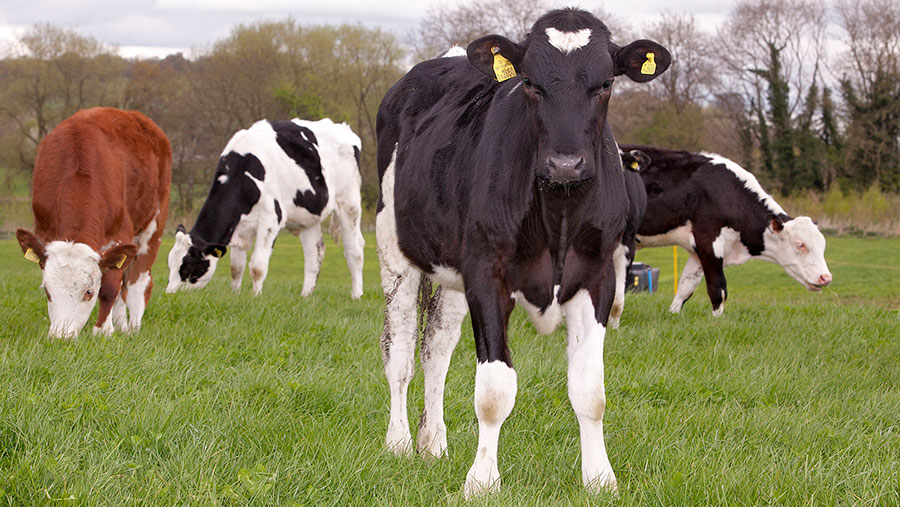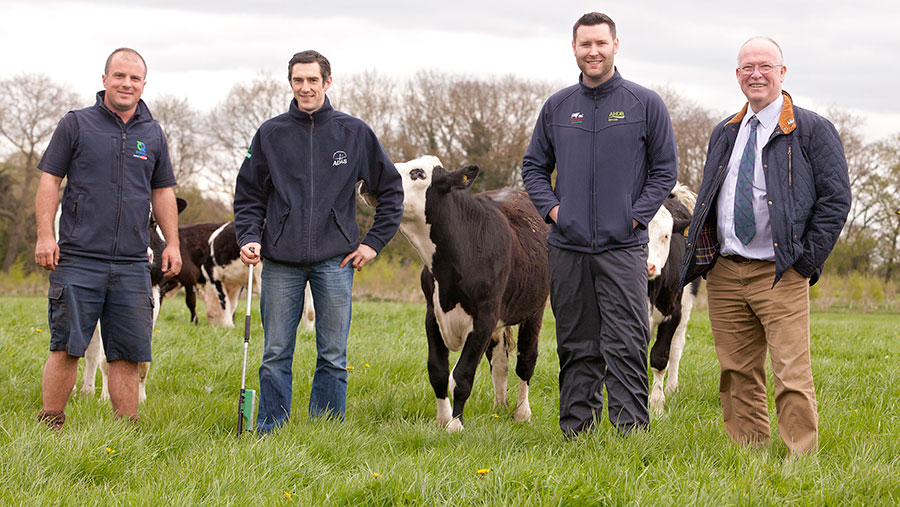How Harper Adams aims to maximise dairy beef growth rates
 So far Hereford crosses are outperforming dairy bred calves © Jonathan Page
So far Hereford crosses are outperforming dairy bred calves © Jonathan Page In a trial that is a first of its kind, Harper Adams University is investigating whether they can finish dairy-bred beef from forage-based diets by 20-21 months.
It is hoped the project, which is being funded by AHDB Beef and Lamb and supported by the Hereford Cattle Society and Dunbia, will create a blueprint for a low-cost beef finishing system for summer- and autumn-born calves.
Over the next 12 months Farmers Weekly will be following their progress.
See also: Beef producers urged to make more from grass to cut costs
In the first article Rhian Price visits the university, where the trial is being undertaken, to report on the results with calves now turned out for their first summer grazing.
Beef and dairy bred steers are going to be challenged to put on 1kg per day from forage without any concentrate supplementation while at grass in the latest finishing study carried out by Harper Adams.
The pioneering project will finally give farmers an insight into whether dairy-bred beef animals can pack as big a punch as their suckler contemporaries on extensive forage systems.
With ever-changing and increasingly challenging markets, Harper Adams’ beef cattle specialist Simon Marsh recognises there is a need for the university to broaden its scope.
“It is a completely new concept for the university, which has traditionally run intensive barley beef systems for more than 40 years,” says Mr Marsh.
“With recent volatility of cereal prices and some market resistance to young bulls it is important to create a blueprint for a sustainable, profitable ‘calf to beef system’ that will not be reliant on price changes in feed. We are having to adopt a completely new mind-set,” he adds.
Initial results already indicate that Hereford x calves are putting on more weight at grass (see table: Calf weights and growth).
About the trial: rearing and pre-grazing
Key measurements during the trial
- Monthly measurements of animal weights and DLWGs
- Weekly grass covers
- Fodderbeet analysis to include DM, ME, CP, digestibility and sugars
- Dry matter yields of the fodderbeet and grass
- Stocking rates
- Carcass weights and grades (cattle slaughtered at Dunbia)
- Meat tenderness, colour, pH (carried out by Dunbia)
- Animal health treatments
- Soil assessment pre- and post-fodderbeet
- Kg’s of liveweight produced per hectare
- Profitability per beast and hectare
The trial began in October, when 70 autumn-born steer calves, weighing around 60kg liveweight at 25-33 days old, were purchased from a range of farms.
The group is split equally into 35 Hereford x Holstein-Friesian and 35 Holstein-Friesians. All Hereford calves are sired by registered bulls and therefore qualify for the premium slaughter schemes.
Calves were reared at RSK ADAS consultant Marc Jones’s farm in Powys before being moved to Harper Adams in January at approximately 14 weeks of age.
In week one calves were fed 1.5 litres of skimmed milk powder twice a day at 200g/litre (600g CMR), but this changed to a 50% skimmed and 50% whey-based powder in week two, fed at the same rate.
In week three they received a whey-based powder only, fed at two litres once a day (400g CMR) up to weaning at week four. Alongside milk, calves were offered ad-lib straw and starter concentrate.
Once at Harper, steers gradually transitioned onto a silage and restricted concentrate diet.
At Mr Jones’s farm the calves had been eating 5kg of concentrates alongside straw so it needed to be a gradual transition down to 2.6kg of a 20% rearer nut and big bale silage.
The big bale silage had a protein content of just 10.2%, hence the requirement to feed a 20% CP nut. This was changed to a 14% CP nut fed at 2kg a head a day at turnout on the 8 March onto grass, when calves were given access to a pasture adjacent to the shed.
Grazing
On 3 April, they were moved into a 10ha paddock grazing system, with paddocks split into 1ha using electric fencing.
The 10ha, which is sown with a mix of perennial rye grasses, received a dressing of urea in March spread at a rate of 30kg/ha. After most grazings, slurry is applied at 30m3 per ha.
Calves enter pastures at 2,500-3,000kg of DM/ha and are moved every 2-3 days once residuals hit 1,500kg of DM/ha.
To control grass growth some paddocks are already being shut up for silage and these bales will then be fed to the calves when they are over-wintered on fodderbeet later this year, so the whole block is self-sustaining.

Chris Ruffley, Marc Jones, AHDB’s Bill Reilly and Simon Marsh (left to right) are all involved in the trial © Jonathan Page
ADAS’s Mr Jones, who is overseeing the trial alongside Mr Marsh and assistant farm manager Chris Ruffley, says next year they will be able to better control grass growth by setting up a leader follower system when another 70 calves are introduced to the trial.
Not only will stocking rates be increased but grass utilisation, too, as older animals can follow younger ones and really clean up pastures, he adds.
“The target will be to achieve a DLWG in excess of 1kg throughout the grazing period.
“Most beef producers achieve this in the first half of the grazing season but often it goes pear-shaped in the second half with variable grass quality and ends up with overall summer DLWGs of just 0.8kg,” says Mr Marsh.
Throughout the trial calves will be weighed monthly and grass covers measured weekly using a plate meter by Mr Ruffley, who manages the calves on a daily basis.
Calf weights and growth |
Hereford x Holstein-Friesian |
Holstein-Friesian |
|
Start age (days) |
24.9 |
33.1 |
|
Wt at start (kg) |
61.6 |
60.8 |
|
Wt at 20 Jan (kg) |
138.9 |
139.7 |
|
DLWG (start – 20 Jan) |
0.87 |
0.97 |
|
Wt at turnout (8 Mar) (kg) |
180.8 |
182.8 |
|
DLWG 20 Jan to 8 Mar (kg) |
0.89 |
0.92 |
|
Wt at 3 April (kg) |
196.9 |
192.1 |
|
DLWG 8 Mar to 3 April (kg) |
0.62 |
0.36 |
|
Overall DLWG 20 Jan to 3 April (kg) |
0.79 |
0.72 |
Results so far have shown:
- Holstein-Friesians grew better initially while on concentrate and milk and therefore averaged 2kg heavier than Hereford calves
- Since turnout, however, Hereford calves have achieved better DLWG of +0.26kg and therefore have overtaken the weights of Holstein x Friesian calves
“The black and whites don’t seem to have the natural ability to graze, which is maybe the trait of the Holstein,” says Mr Marsh.
“At the end of the day we will find out if they can cope with this system, but may have to resort to the feed bag to get some fat cover,” he adds.
Objectives and aims
The aim is to maximise growth rates and reduce finishing age to 20-21 months by strip grazing cattle on 4ha of fodderbeet from November to March. The steers will then be re-introduced to the paddock grazing system next spring.
Maximising growth rates on fodderbeet will be key to finishing them quickly off grass and avoiding another winter – something Mr Jones says can kill profits.
“The third winter can add on £200-300, which would wipe out our profits. At the same time the cost of out-wintering in the growing phase will be half that of housing,” says Mr Jones.
They hope to finish all animals by June 2017 at 320-340kg carcass weight and a fat class of 3-4L, with everything sold deadweight to Dunbia. Meat tenderness, colour and pH will be measured, too, by Dunbia.
The university also has a group of 50 October-born Simmental and Blue x Holstein-Friesians, which would normally be finished as bulls but have been castrated. They will be grazed this summer (on a different unit) and then brought inside in October to finish at 16-18 months old on either ad-lib cereals or 50:50 cereals:maize silage.
“It will be interesting to compare these two systems, as well and look at the variable and fixed costs,” notes Mr Marsh, who aims to make a net profit of £200-300/head from the extensively finished calves, with concentrate only offered to tail-enders.
“We are basically stripping out all the major costs associated with beef production and maximising DLWG on cheap high-quality forage. If we don’t make a decent profit with this system – no one will.”
Key stages in the trial
|
Trial stage |
Timings |
Practice |
Targets |
|
Calf-rearing/pre-turnout |
October 2016-March 2017 |
Calves reared on milk before transitioning onto a concentrate and silage diet |
120kg liveweight gain at the end of the period |
|
First summer grazing |
March- October 2017 |
Calves transitioned onto a grass-only diet and rotationally grazed |
50% pasture use early in season increasing to 80-85% with target DLWGs in excess of 1kg |
|
Winter fodderbeet |
November 2017-February 2018 |
Strip graze fodderbeet with access to silage |
Minimum of 0.7kg DLWG. End weight of 485kg |
|
Second summer grazing |
March-June/July 2018 |
Rotationally graze 10ha |
Minimum DLWG of 1.3kg. End weight of 625-650kg. Killing out 50% for Black and Whites and 53% for Herefords |
